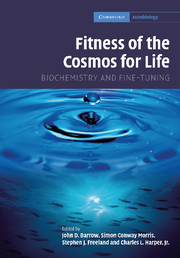Book contents
- Frontmatter
- Contents
- List of contributors
- Foreword: The improbability of life
- Preface
- Acknowledgments
- Part I The fitness of “fitness”: Henderson in context
- Part II The fitness of the cosmic environment
- Part III The fitness of the terrestrial environment
- 10 How biofriendly is the universe?
- 11 Tuning into the frequencies of life: a roar of static or a precise signal?
- 12 Life on earth: the role of proteins
- 13 Protein-based life as an emergent property of matter: the nature and biological fitness of the protein folds
- 14 Could an intelligent alien predict earth's biochemistry?
- 15 Would Venus evolve on Mars? Bioenergetic constraints, allometric trends, and the evolution of life-history invariants
- Part IV The fitness of the chemical environment
- Index
- References
15 - Would Venus evolve on Mars? Bioenergetic constraints, allometric trends, and the evolution of life-history invariants
Published online by Cambridge University Press: 18 December 2009
- Frontmatter
- Contents
- List of contributors
- Foreword: The improbability of life
- Preface
- Acknowledgments
- Part I The fitness of “fitness”: Henderson in context
- Part II The fitness of the cosmic environment
- Part III The fitness of the terrestrial environment
- 10 How biofriendly is the universe?
- 11 Tuning into the frequencies of life: a roar of static or a precise signal?
- 12 Life on earth: the role of proteins
- 13 Protein-based life as an emergent property of matter: the nature and biological fitness of the protein folds
- 14 Could an intelligent alien predict earth's biochemistry?
- 15 Would Venus evolve on Mars? Bioenergetic constraints, allometric trends, and the evolution of life-history invariants
- Part IV The fitness of the chemical environment
- Index
- References
Summary
If there is ever a time in which we must make profession of two opposite truths, it is when we are reproached for omitting one.
– Pascal, PenséesIntroduction
A famous metaphor in integrative biology refers to the relationship between environmental constraint and evolutionary change as “the ecological theater and the evolutionary play” (Hutchinson, 1965). In the forty years since the penning of that phrase, the relationship between play and stage has been a matter of vigorous and fascinating debate. The issues have profound implications, not only for our scientific account of the evolutionary process, but also for our expectation of what life might look like on other planets and, indeed, for our philosophical and theological understandings of what it might mean on this one.
The controversy involves differing conclusions about the roles of contingency and constraint in evolutionary history, including, among other things, the way in which fundamental regularities of the physico-chemical environment, or “stage,” influence the unfolding of the evolutionary drama. On the one hand, many prevalent expositions of the evolutionary play suggest that the fundamental or ultimate actors are genes, not organismic (much less mental) agents (Dawkins, 1976, 1998; Dennett, 1995). The drama itself is a theater of the absurd, a plotless improvisation using whatever props are contingently provided by the environment (Gould, 1989, 1996). Contingency is held to exert determinative influence on history, and, according to Stephen Gould's widely cited metaphor, “we would probably never arise again even if life's tape could be replayed a thousand times” (1989, p. 234).
- Type
- Chapter
- Information
- Fitness of the Cosmos for LifeBiochemistry and Fine-Tuning, pp. 318 - 346Publisher: Cambridge University PressPrint publication year: 2007
References
- 3
- Cited by

